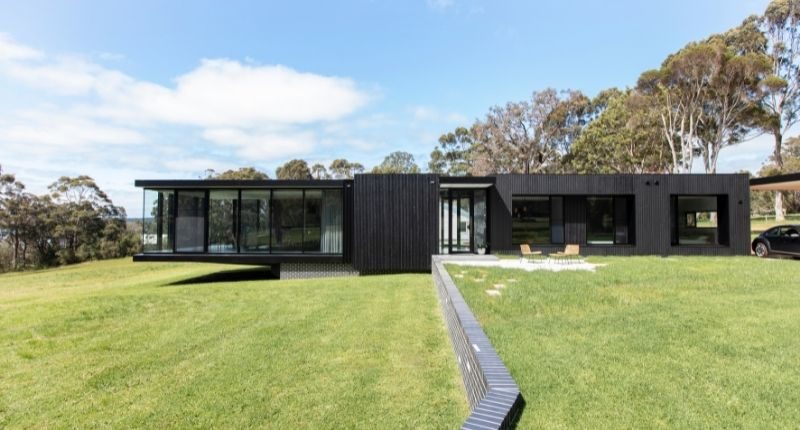- Clients were adamant in their 'buy local' philosophy
- Glazing, while complex, was completed by Denmark tradies
- Features a cantilevered form over a grass hill
David Gibson and Melanie Hoessle live on the neighbouring property and had spent much time walking on their client’s site over the years.
They had enjoyed the spectacular views of the river, forest and hills, and imagined what could be built on this unique piece of West Australian landscape.
They also knew their clients, having worked with them before on the Denmark Surf Life Saving Club project.
When it came time to make a start on the design for this project, Mr Gibson and Ms Hoessle had many ideas and initially tested a number of schemes and options.
However, they ultimately settled on a concept for a smaller footprint, so as not to overpower the historic “Bonnie View” cottage located on the site, an early settlers cottage dating back to early last century.
“We didn’t want the addition to be too high, too wide, too large. We wanted the old home to be prominent still,” said Mr Gibson.

As with all of their projects, Mr Gibson and Ms Hoessle worked closely together on the Little River Residence, their skills complimentary. “We are really two parts of the one. If you pulled us apart I’m not sure we could do it,” said Mr Gibson. They are not only business partners in PTX Architects, but also partners in life.

While Mr Gibson was primarily responsible for the form of the home, it was Ms Hoessle’s engineering background that made it happen – conceptualising a structural system supported by bracing the floor slab and roof, and avoiding the use of diagonal bracing in the glazed sections which would have interrupted the spectacular views.

Working with the structural engineer, Ms Hoessle’s concept was resolved enabling the creation of a cantilevered form which floats effortlessly above the grass below, creating a panorama of the local landscape, and taking maximum advantage of the gentle rolling slope of the site.

Solar-passive design principles are embedded into the project, with high levels of thermal insulation throughout and thermally broken double-glazing systems.
Louvred and sashless windows allow for natural ventilation, and roof overhangs and deep window reveals to the north minimise solar heat gain in summer and maximise solar penetration in winter.

An automated blackout blind system prevents thermal loss, and exposed concrete floors help retain natural heating and cooling.
The residence’s timber fireplace is there purely for ambience – no mechanical heating or cooling systems are needed for thermal comfort.

The sustainably sourced, charred cypress pine timber cladding works on many levels.
It references the charred landscape, it helps the new addition recede into the landscape giving prominence to the old and, above all, performs well in the Denmark microclimate.
In an area with high humidity and temperature fluctuations, the cypress pine cladding provided a robust, low-maintenance and sustainable solution.

Of all of the sustainability initiatives involved in the Little River Residence, it was probably the “buy local” philosophy which adds most to this project’s uniqueness.

The clients had owned and run a commercial building company for many years before opening a hardware store in Denmark. They were adamant the construction methods could be done locally and that only Denmark tradespeople could be used. So even though the structural glazing system was complex, it was completed by Denmark trades, with expert advice and support from Perth.

~~
Written by Sandy Anghie. Photography by Bo Wong.
This story was originally published in The Architect magazine, an official publication of the Australian Institute of Architects. It has been edited for republication by The Property Tribune.
The Property Tribune thanks the Australian Institute of Architects for the opportunity to republish the work, and shine a light on Australian architecture.








